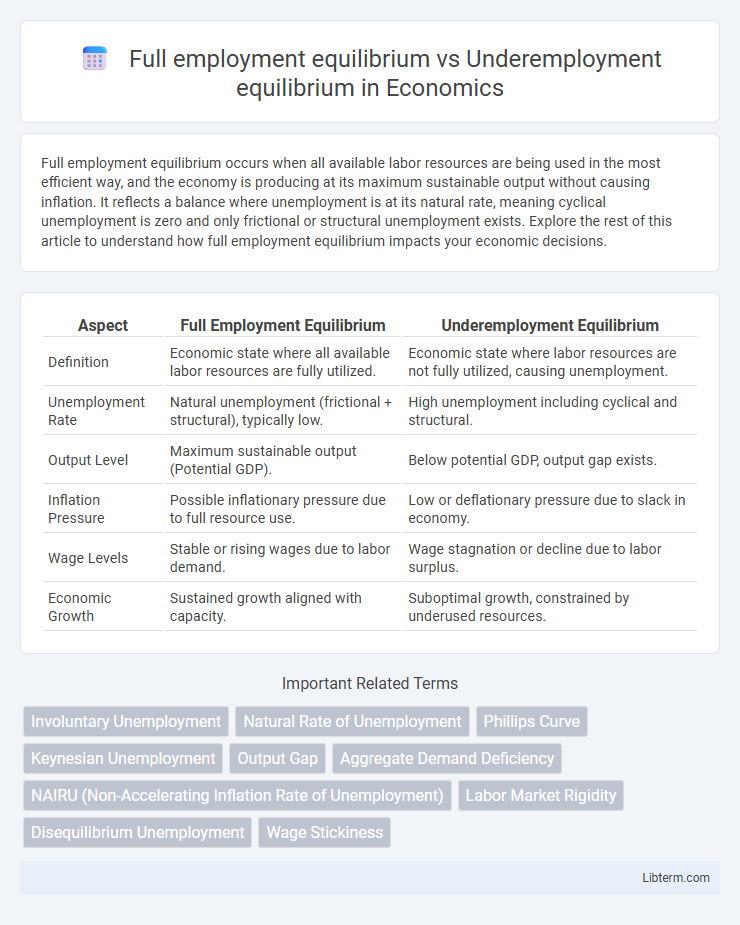Full employment equilibrium occurs when all available labor resources are being used in the most efficient way, and the economy is producing at its maximum sustainable output without causing inflation. It reflects a balance where unemployment is at its natural rate, meaning cyclical unemployment is zero and only frictional or structural unemployment exists. Explore the rest of this article to understand how full employment equilibrium impacts your economic decisions.
Table of Comparison
| Aspect | Full Employment Equilibrium | Underemployment Equilibrium |
|---|---|---|
| Definition | Economic state where all available labor resources are fully utilized. | Economic state where labor resources are not fully utilized, causing unemployment. |
| Unemployment Rate | Natural unemployment (frictional + structural), typically low. | High unemployment including cyclical and structural. |
| Output Level | Maximum sustainable output (Potential GDP). | Below potential GDP, output gap exists. |
| Inflation Pressure | Possible inflationary pressure due to full resource use. | Low or deflationary pressure due to slack in economy. |
| Wage Levels | Stable or rising wages due to labor demand. | Wage stagnation or decline due to labor surplus. |
| Economic Growth | Sustained growth aligned with capacity. | Suboptimal growth, constrained by underused resources. |
Understanding Full Employment Equilibrium
Full employment equilibrium occurs when all available labor resources are fully utilized, resulting in an unemployment rate that reflects only frictional and structural unemployment, typically around 4-5%. At this equilibrium, the economy produces at its potential output, and inflation remains stable due to balanced aggregate demand and supply. Understanding full employment equilibrium involves recognizing that it signifies maximum sustainable growth without triggering excessive inflationary pressures.
Defining Underemployment Equilibrium
Underemployment equilibrium occurs when an economy operates below full employment, with resources, especially labor, not fully utilized, leading to output gaps and higher unemployment rates. This state is characterized by persistent demand deficiencies that prevent wages and prices from adjusting to restore full employment levels. Unlike full employment equilibrium, where all available labor is efficiently employed, underemployment equilibrium signifies chronic underutilization of productive capacity within the economy.
Key Differences Between Full and Underemployment Equilibria
Full employment equilibrium occurs when all available labor resources are utilized efficiently, resulting in maximum output and stable prices, whereas underemployment equilibrium reflects a state where labor and capital are not fully utilized, causing persistent unemployment or underemployment and output gaps. In full employment, wages and prices adjust to clear the labor market, while underemployment equilibrium often features wage rigidities and insufficient demand, preventing the economy from reaching its potential output. This key difference highlights the contrast between optimal resource allocation in full employment and suboptimal utilization in underemployment equilibria.
Causes of Full Employment Equilibrium
Full employment equilibrium occurs when all available labor resources are utilized efficiently, driven by factors such as robust economic growth, high consumer demand, and effective government policies promoting job creation. It results from balanced wage rates, technological advancements, and skilled workforce adaptability that prevent unemployment beyond the natural rate. In contrast, underemployment equilibrium arises from insufficient aggregate demand, structural mismatches in the labor market, and rigid wage structures leading to persistent unemployment or underutilization of labor.
Factors Leading to Underemployment Equilibrium
Underemployment equilibrium occurs when aggregate demand is insufficient to achieve full employment, resulting in excess labor capacity and idle resources. Factors leading to this include persistent wage rigidity, inadequate aggregate demand, structural mismatches in the labor market, and inefficiencies such as low consumer confidence or restrictive monetary policies. These elements prevent the economy from reaching full employment equilibrium, where all available labor resources are optimally utilized.
Economic Indicators for Detecting Equilibria
Full employment equilibrium is characterized by an unemployment rate near the natural rate, stable inflation, and consistent GDP growth reflecting optimal resource utilization. Underemployment equilibrium shows persistent unemployment above the natural rate, sluggish GDP growth, and weak wage pressure indicating underutilized labor and capital. Key economic indicators such as the unemployment rate, GDP output gap, and inflation trends are essential for distinguishing between these equilibrium states.
Consequences of Full Employment on Economic Growth
Full employment equilibrium maximizes productive capacity, leading to sustained economic growth through optimal resource utilization and increased consumer spending. Underemployment equilibrium results in idle labor and capital, hindering GDP growth and causing persistent economic inefficiencies. Achieving full employment boosts productivity, investment levels, and innovation, ultimately accelerating long-term economic expansion.
Social and Economic Impacts of Underemployment
Underemployment equilibrium occurs when labor resources are not fully utilized, leading to reduced income levels and lower consumer spending, which negatively affect economic growth. Social impacts include increased job dissatisfaction, mental health issues, and widened income inequality, which exacerbate poverty and social unrest. Full employment equilibrium maximizes productive capacity and social stability, fostering higher living standards and economic resilience.
Policy Interventions for Achieving Full Employment
Policy interventions for achieving full employment equilibrium include active fiscal policies such as increased government spending on infrastructure projects and targeted tax incentives to stimulate job creation. Monetary policies that lower interest rates encourage business investment and consumer spending, further promoting labor market expansion. Labor market reforms, including vocational training and improved matching services, enhance workforce skills and reduce structural unemployment, moving the economy closer to full employment equilibrium.
Comparative Analysis: Full Employment vs Underemployment Equilibrium
Full employment equilibrium occurs when all available labor resources are utilized efficiently, resulting in maximum output without inflationary pressure, while underemployment equilibrium reflects a state where labor and other resources remain underutilized, causing persistent unemployment or underemployment and reduced economic growth. In full employment equilibrium, wages tend to stabilize, and aggregate demand equals aggregate supply, fostering economic stability, whereas underemployment equilibrium is marked by suppressed wages and insufficient aggregate demand, leading to stagnation. The comparative impact on productivity, income distribution, and fiscal policy effectiveness highlights the critical differences between these two economic states.
Full employment equilibrium Infographic

 libterm.com
libterm.com